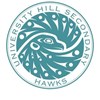Modern Languages
BONJOUR!
FRENCH 8 and FRENCH 9
What is AIM?
In the junior levels, French 8, French 9, and French 10 are taught using a new approach to learning. This new method is called THE AIM METHOD (Accelerated Integrative Method). Many Vancouver Schools have adopted this method and it is also taught in the USA, Australia and is growing around the world helping to teach French, English, Spanish and Mandarin. With AIM, authentic learning is achieved through scaffolding techniques which use storytelling, gestures, active collaboration, and repetition. The use of high-frequency vocabulary, introduced with gestures and contextualized in stories, drama, songs, and dance, allows students to rapidly achieve levels of oral and written proficiency rarely seen with conventional methods.
AIM is a sequential program designed to accelerate the acquisition of French as a second language for students with little or no fluency in the language.
- Successful at promoting fluency – a highly communicative program that meets all provincial ministry outcomes
- Modular and sequential, with emphasis on developmental learning
- A program that ensures an extensive vocabulary is taught, then subsequently reviewed, and consolidated from one unit to the next
- A program that builds on students’ past experiences
- Motivating
- Flexible and adaptable allowing teachers to customize activities to suit every situation and all students
- Based on a variety of proven successful techniques, strategies and methodologies
- A program that promotes the development of higher-level thinking skills
- A truly multidimensional approach
FRENCH 10
Using the Common European Framework of Reference for Languages (CEFR), students in French 10 will be building on their competencies from French 9. Students in French 10 will be transitioning from A1 fluency to A2 fluency. Students will be encouraged to participate in French and become increasingly autonomous in their language acquisition. In this class, emphasis will be placed on students’ abilities to express themselves with increasing fluency both orally and in writing while engaging in conversations about familiar topics. Students in this class will broaden and deepen their current French knowledge with a variety of activities and assessments about their social life, personal life and multimedia comprehension.
FRENCH 11
Using the Common European Framework of Reference for Languages (CEFR), students in French 11 will be building on their competencies at an A2 level of fluency, focusing on expressing themselves with respect to personal life, social life, and multimedia comprehension in greater degrees of complexity. We will explore and respond to authentic cultural works from the Francophone world. In this course, students will also study countries of the French speaking world and identify the contributions of Francophones to Canada and the world. Students will study similarities and differences between Francophone cultures and their own.
FRENCH 12
Using the Common European Framework of Reference for Languages (CEFR), students in French 12 will be transitioning between an A2 and B1 level of fluency, moving from Basic to Independent Users. Students continue to develop listening, writing and speaking skills, to expand control of basic vocabulary and grammatical structures and to improve their general ability to read and write in French. We will explore and respond to authentic cultural works from the Francophone world. In this course, students will continue their study of countries of the French speaking world through literature, art, and film. They will discuss contemporary issues in the Francophone world.
HOLA!
SPANISH 10
Students will engage in classroom conversations, comprehend written and spoken language, and recognize the relationships between Spanish letter patterns, pronunciation and meaning. They will develop strategies to increase understanding of vocabulary and grammar (present tense of verbs, numbers, stem-changing verbs, family structures, and the present progressive). No previous experience in Spanish is needed.
SPANISH 11
Students will engage in classroom conversations, comprehend written and spoken language, and recognize the relationships between Spanish letter patterns, pronunciation, and meaning. They will develop strategies to increase understanding of vocabulary and grammar (verbs in the preterite, object pronouns, comparisons, travel and fashion).
Experience conjugating regular verbs, the use of hay and tener, using numbers, and telling time is necessary for success.
Students will feel ready if they can hold basic conversations about family, school courses, and identity.
SPANISH 12
Students will engage in classroom conversations, comprehend written and spoken language, and create original compositions. They will develop strategies to increase understanding of vocabulary and grammar (regular and irregular verbs in the preterite, imperfect tense, subjunctive, and imperative use; vocabulary around food, holidays, and health).
Experience in all Spanish 11 skills, plus conjugating stem-changing verbs, verbs in the preterite, using direct object pronouns, and saber and conocer is necessary for success. Students will feel ready if they can hold detailed conversations about family, school, vacations, hobbies, and clothing.

